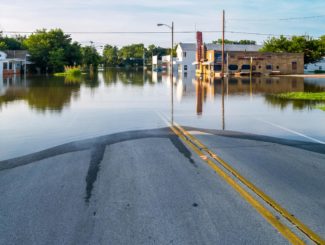When beginning the development of a wind farm, it’s not just the physical design of a property you should consider, but the environmental factors as well.
Consider the eagles before development
As environmental scientists, our role is to inform our clients about the risks to natural resources and wildlife; in particular, avian life. Using information about the natural environment, we can provide recommendations to our clients for ideal locations to construct potential wind turbines. Wind energy infrastructure can pose a great risk to birds and eagles and our research helps protect them from turbine injuries and/or fatalities. If an eagle is killed or injured by a windmill, the wind farm owner may be in violation of a federal law and face a penalty.
Wind farm eagle surveys
WSB has recently been collecting data about the presence of golden and bald eagles at a wind farm project in Montana. In recent surveys, golden eagles have been observed at the 6,000-acre site and are potentially at-risk from the wind farm development. Golden and bald eagles are protected by the Bald and Golden Eagle Act created in 1940 (and expanded to include goldens in 1962). When protected species are found to be present on a development site, an extensive two-year study, data analysis and risk calculations must be considered prior to development.
WSB understands and adheres to the recommendations and guidance of the region 6 USFWS and the 2013 Eagle Conservation Plan Guidance when conducting site assessments for eagle use at potential wind farm locations.
Two-year data collection
This past September, we began a two-year process of raptor point count surveys to study eagle land and air usage at the wind farm site. Our environmental scientists visit Montana monthly to collect data regarding eagle activity at the site location. Field work during these evaluations includes visual eagle activity surveys, eagle nest surveys, and eagle prey abundance observation that can be used to identify the impacts of a wind farm on avian life.
We compile and record information about the weather conditions, species sitings, eagle flight paths, eagle behavior, and age class. Our scientists are not only measuring avian activity but also noting whether eagle prey, such as antelope and prairie dogs, are present. We then analyze, compile, and summarize the data for our clients. At the end of the two-year study, all data will be analyzed forecasting the potential risk to eagles from wind farm development. If risk levels are high, the client can apply for an eagle take permit through the United States Fish and Wildlife Service (USFWS) and develop an Eagle Conservation Plan for the site.
Eagle safety is our top priority
Not all wind farms require an extensive two-year study as each potential site is different. If protected species, such as eagles, or species of concern aren’t present or observed at the site, the above approach may not be required. When risk levels for harming avian and raptor life are low, the process of wind farm development and construction can be streamlined.
This renewable energy source poses less risk to birds and wildlife than other energy sources, but it’s important to take the necessary precautions before development begins. Our environmental scientists evaluate conservation risks and make evidence-based recommendations for research, best management practices and siting locations that protect avian species with a low amount of risk. The goal for wind farm development is to help our clients develop renewable energy resources while reducing impacts to wildlife.
Environmental Scientist, Jordan Wein explains how tracking the activity of raptors can support wind farm development and minimize the risk to raptors and other birds.

